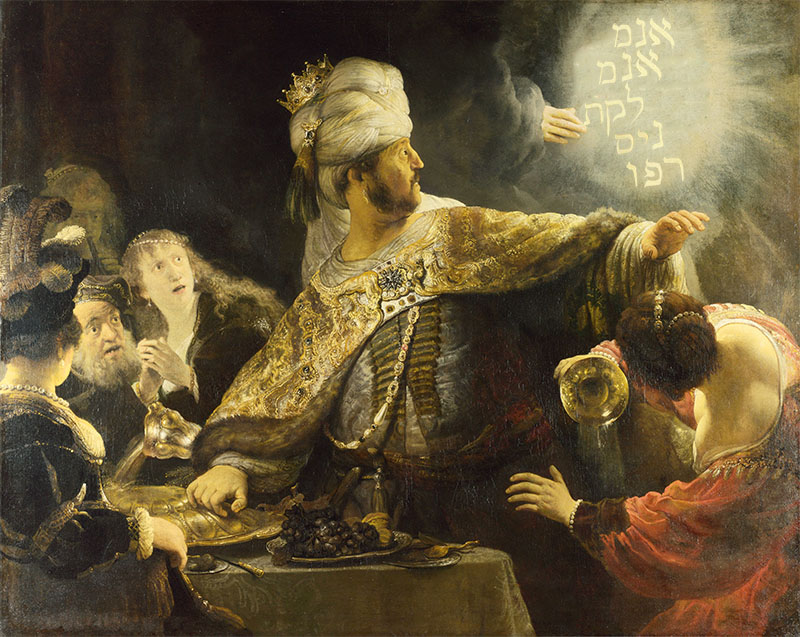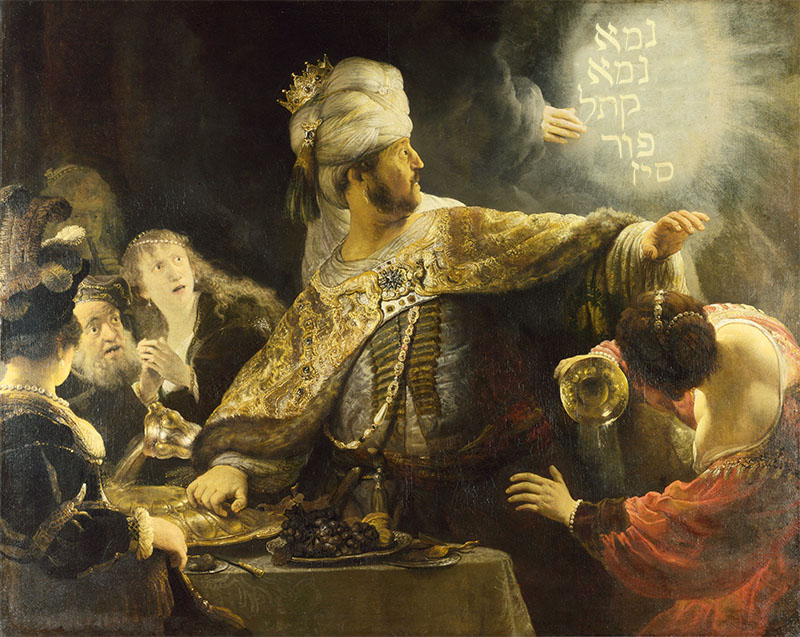5. Alors apparurent les doigts d’une main d’homme, et ils écrivirent, en face du chandelier, sur la chaux de la muraille du palais royal. Le roi vit cette extrémité de main qui écrivait.
6. Alors le roi changea de couleur, et ses pensées le troublèrent; les jointures de ses reins se relâchèrent, et ses genoux se heurtèrent l’un contre l’autre.
7. Le roi cria avec force qu’on fît venir les astrologues, les Chaldéens et les devins; et le roi prit la parole et dit aux sages de Babylone: Quiconque lira cette écriture et m’en donnera l’explication sera revêtu de pourpre, portera un collier d’or à son cou, et aura la troisième place dans le gouvernement du royaume.
8. Tous les sages du roi entrèrent; mais ils ne purent pas lire l’écriture et en donner au roi l’explication.
...
24. C’est pourquoi il a envoyé cette extrémité de main qui a tracé cette écriture.
25. Voici l’écriture qui a été tracée: Compté, compté, pesé, et divisé.
26. Et voici l’explication de ces mots. Compté: Dieu a compté ton règne, et y a mis fin.
27. Pesé: Tu as été pesé dans la balance, et tu as été trouvé léger.
28. Divisé: Ton royaume sera divisé, et donné aux Mèdes et aux Perses.
29. Aussitôt Belschatsar donna des ordres, et l’on revêtit Daniel de pourpre, on lui mit au cou un collier d’or, et on publia qu’il aurait la troisième place dans le gouvernement du royaume.
30. Cette même nuit, Belschatsar, roi des Chaldéens, fut tué.
And the writing of the letter was written in the Aramaic character and interpreted into the Aramaic.
And again it is written, And they could not read the writing nor make known to the king the interpretation thereof.
...
But what can the phrase, they could not read the writing, mean
on the view of R`Simeon, who asserts that this writing was not changed?
- Rab said: The passage was written in Gematria:
Y-T-T.
Y-T-T.
A-D-K.
P-U-G-H-M-T.
How did he interpret it to them? - As
M-N-A.
M-N-A.
T-K-L.
U-F-R-S-Y-N.
...
Samuel said: It was written thus:
M-M-T-U-S.
N-N-K-F-Y.
A-'A-L-R-N.
R`Johanan said: It was written:
A-N-M.
A-N-M.
L-K-T-N-Y-S-R-F-U;
while R`Ashi says: It was written:
N-M-A.
N-M-A.
K-T-L.
F-U-R-S-Y-N.



